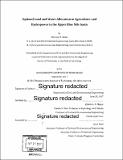| dc.contributor.advisor | Elfatih A. B. Eltahir. | en_US |
| dc.contributor.author | Allam, Mariam M.(Mariam Mohammed Nasr El Din Ibrahim) | en_US |
| dc.contributor.other | Massachusetts Institute of Technology. Department of Civil and Environmental Engineering. | en_US |
| dc.coverage.spatial | f-sj---f-et--- | en_US |
| dc.date.accessioned | 2018-02-08T16:25:21Z | |
| dc.date.available | 2018-02-08T16:25:21Z | |
| dc.date.copyright | 2017 | en_US |
| dc.date.issued | 2017 | en_US |
| dc.identifier.uri | http://hdl.handle.net/1721.1/113470 | en_US |
| dc.description | Thesis: Ph. D., Massachusetts Institute of Technology, Department of Civil and Environmental Engineering, 2017 | en_US |
| dc.description | Cataloged from PDF version of thesis. | en_US |
| dc.description | Includes bibliographical references (pages 178-190). | en_US |
| dc.description.abstract | The Nile basin is an ecosystem under stress due to rapid population growth, urgent needs for more efficient utilization of natural resources, potential impacts of climate change, and persistent conflicts between riparian countries on the limited set of resources. This thesis develops a framework for optimal allocation of land and water resources to agriculture and hydropower production in the upper Blue Nile (UBN) basin, which contributes about 60 percent of the Nile river flow. The framework consists of three optimization models that aim to: (a) provide accurate estimates of the basin water budget components, (b) allocate land and water resources optimally to rain-fed, and irrigated agriculture, and (c) allocate water to agriculture and hydropower production, and investigate trade-offs between them. This thesis makes two methodological contributions. | en_US |
| dc.description.abstract | First, a data assimilation procedure suitable for data-scarce basins is proposed to deal with data limitations and produce estimates of hydrologic components especially evaporation, consistent with the principles of mass and energy conservation while also fitting closely available observations from satellite remote sensing and ground stations. The spatial distribution of evaporation from the UBN basin is poorly known. This thesis provides new spatial maps of the monthly evaporation. Second, the most representative datasets on topography and soil properties are objectively identified, compared to other datasets, and used to delineate the arable land in the basin. Maps of suitable soils are incorporated into a land-water allocation model that allows for enhancement of the soils from one suitability class to another to increase agricultural productivity in return for an investment in soil inputs such as fertilizers. | en_US |
| dc.description.abstract | The assimilated hydrology and the delineated arable lands are used as input to an optimization model that allocates land to rain-fed agriculture while maximizing the total net economic benefits. The same framework is extended to incorporate irrigated agriculture in the basin. Eleven proposed irrigation projects are screened, and only three of them were found economically attractive. This optimal agricultural expansion, including rain-fed and irrigated agriculture, is expected to reduce the basin flow by 7.6 cubic kilometres, impacting countries downstream from the UBN. Cooperation scenarios that limit the magnitude of this reduction are studied and their impact on the net economic benefit is quantified. The optimization framework is expanded further to include hydropower production. Optimal operation rules for the Grand Ethiopian Renaissance dam (GERD) are identified to maximize annual hydropower generation from the dam while achieving a relatively uniform monthly production rate. | en_US |
| dc.description.abstract | Trade-offs between agricultural expansion and hydropower generation are analysed in an attempt to define scenarios for cooperation that would achieve win-win outcomes for all riparian countries of the basin. | en_US |
| dc.description.statementofresponsibility | by Mariam M. Allam. | en_US |
| dc.format.extent | 190 pages | en_US |
| dc.language.iso | eng | en_US |
| dc.publisher | Massachusetts Institute of Technology | en_US |
| dc.rights | MIT theses are protected by copyright. They may be viewed, downloaded, or printed from this source but further reproduction or distribution in any format is prohibited without written permission. | en_US |
| dc.rights.uri | http://dspace.mit.edu/handle/1721.1/7582 | en_US |
| dc.subject | Civil and Environmental Engineering. | en_US |
| dc.title | Optimal land and water allocation to agriculture and hydropower in the Upper Blue Nile basin | en_US |
| dc.type | Thesis | en_US |
| dc.description.degree | Ph. D. | en_US |
| dc.contributor.department | Massachusetts Institute of Technology. Department of Civil and Environmental Engineering | en_US |
| dc.identifier.oclc | 1019902566 | en_US |
| dc.description.collection | Ph.D. Massachusetts Institute of Technology, Department of Civil and Environmental Engineering | en_US |
| dspace.imported | 2019-06-17T20:46:53Z | en_US |
